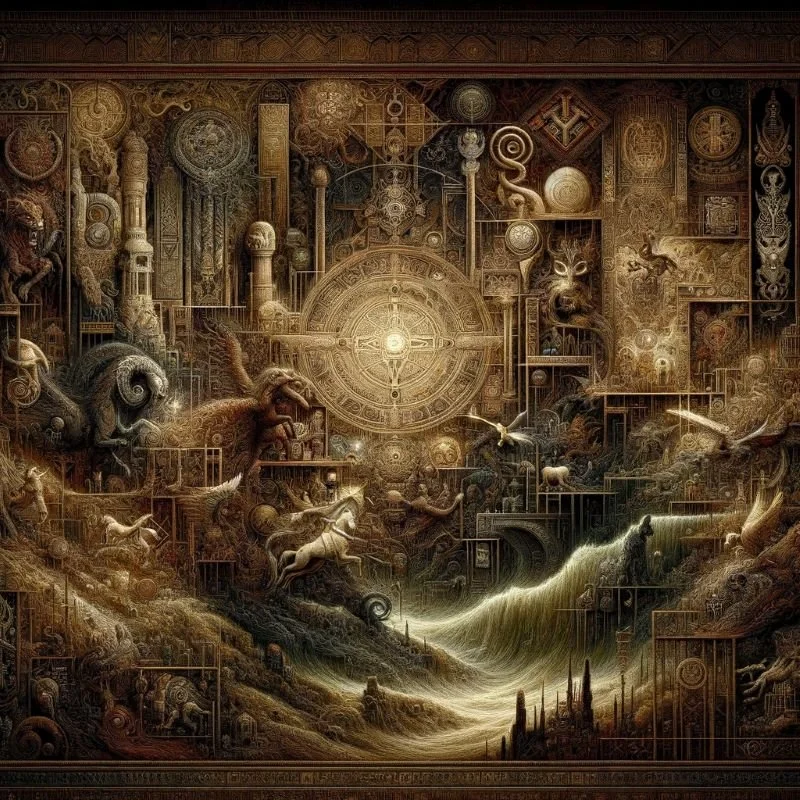Welcome, intrepid explorers, to the shadowy nexus where dark fantasy meets cultural influence. Here, ancient myths whisper in the wings, folklore twists through the narrative, and the echoes of history add depth to the darkness. But what is it about these cultural elements that so enrich the realms of dark fantasy? How do they shape the stories that both terrify and enchant us? Prepare to embark on a journey through time and imagination as we unravel the intricate web of influences that give dark fantasy its enduring power and appeal.
Myths and Monsters: The Roots of Dark Fantasy
Dark fantasy is a genre deeply rooted in the rich soil of mythology and folklore, drawing from ancient archetypes and timeless terrors to create narratives that resonate with primal fears and fascinations. It’s a realm where the echoes of ancient tales mingle with modern imaginings, creating a tapestry woven from the threads of the past and present. Let’s delve into the mythological foundations and monstrous inheritances that form the backbone of dark fantasy.
Ancient Archetypes and Timeless Terrors
Mythological Foundations: At its core, many dark fantasy narratives are anchored in the myths and legends that have shaped human culture. These stories are not just retellings but reimaginings, infused with contemporary themes and sensibilities. From the vengeful gods of ancient Greece to the trickster spirits of Native American lore, dark fantasy borrows from a diverse cultural tapestry, infusing age-old tales with new energy and perspective. This genre doesn’t just replicate myths; it revives them, breathing new life into ancient narratives and making them relevant for a modern audience.
Monstrous Inheritances: The creatures that prowl the pages of dark fantasy are often descendants of cultural lore, reimagined for today’s readers. Dragons, demons, and other denizens of the dark are not just monsters; they’re symbols, carrying the weight of centuries of fear, fascination, and storytelling. While these beings are updated for contemporary narratives, they retain the primal essence that has made them enduring icons across cultures and eras. They remind us that some fears are universal, transcending time and geography.
Folklore Reimagined: A Haunting Heritage
Twisting the Traditional: Dark fantasy takes the familiar threads of folklore and weaves them into something altogether more sinister and complex. Cautionary tales and moral fables are transformed into narratives where the morals are murky and the stakes are existential. This genre doesn’t just retell traditional stories; it reinvents them, exploring the darker implications and hidden corners of tales we thought we knew. In doing so, dark fantasy creates a space where the past and present collide, where ancient fears find new expressions.
The Universal and the Unique: While dark fantasy taps into universal themes of fear, power, and morality, it also celebrates cultural specificity, drawing on particular regional folklore to craft stories that are both globally resonant and locally rooted. This approach not only adds depth and authenticity to the narrative but also highlights the rich diversity of human storytelling. By incorporating specific cultural elements, dark fantasy acknowledges that while the human experience is universal, it is also wonderfully varied and complex.
Echoes of the Ancient: The Continuing Legacy of Myths and Monsters
Dark fantasy is a conversation between the past and present, a narrative dance that brings ancient myths and monsters into the modern age. It’s a genre that respects its roots while continually pushing boundaries, exploring new territories of fear and fascination. As we read these stories, we’re not just entertained; we’re connected to a long lineage of human imagination, a legacy of myths and monsters that has shaped our understanding of the world and ourselves. In the realms of dark fantasy, the ancient and the contemporary merge, reminding us that the stories we tell are as timeless as they are ever-evolving.
Historical Hauntings: The Shadows of the Past
Dark fantasy serves as a portal to the past, a realm where history’s echoes reverberate through tales of supernatural intrigue and moral complexity. This genre doesn’t just recreate historical settings; it haunts them with the ghosts of what might have been, blending the real with the surreal. Let’s explore how dark fantasy draws on the shadows of the past, creating narratives that resonate with the echoes of events and the impact of cultural trauma.
Echoes of Events
The Ghosts of History: Dark fantasy often seizes upon historical events, using them as fertile ground for stories that delve into the darker side of human nature. Wars, revolutions, and social upheavals aren’t just backdrops; they’re catalysts for narratives that explore power, corruption, and the moral dilemmas that arise in times of turmoil. These settings provide a rich context for stories that are as much about the human condition as they are about supernatural elements, offering a haunting glimpse into what lurks in the heart of human conflicts.
The Anachronistic and the Arcane: In dark fantasy, the past is not just revisited; it’s reimagined. By weaving together historical accuracy with elements of magic and the supernatural, this genre creates a tapestry where the anachronistic and the arcane intertwine seamlessly. This blending invites readers to consider how history and myth influence each other, how the events of the past might have unfolded differently in a world where the supernatural is real. It’s a narrative alchemy that turns history into something not just to be remembered but to be experienced.
The Impact of Cultural Trauma
Reflecting Collective Fears: Dark fantasy often mirrors the cultural traumas of societies, transforming collective fears and anxieties into narratives that entertain, disturb, and perhaps even heal. Whether it’s the specter of war, the shadow of plague, or the echoes of social upheaval, these stories give form to the formless, making the intangible fears of a society something that can be confronted on the page. In doing so, dark fantasy offers a way to understand and, in some ways, come to terms with the darker chapters of history.
A Lens on the Human Condition: Through its exploration of historical and cultural traumas, dark fantasy provides a unique lens through which to view the impact of these events on the human psyche. These narratives delve into themes of loss, despair, resilience, and the endless quest for meaning in a world that often seems steeped in shadow. They remind us that, even in the darkest of times, the struggle to find light and understanding is a fundamental part of the human experience.
Haunting the Present: The Ongoing Legacy of the Past
Dark fantasy’s historical hauntings remind us that the past is never truly dead; it lingers in the shadows of our collective memory, shaping the present and the future. As we explore these narratives, we’re not just reading stories; we’re engaging with the echoes of what once was and what might have been. In the realms of dark fantasy, the shadows of the past are not just remembered; they are felt, experienced, and understood, offering a haunting yet illuminating journey through the corridors of history and the human heart.
The Global Grimoire: Dark Fantasy in a Diverse World
In the ever-expanding world of dark fantasy, the boundaries of imagination extend far beyond any single culture or tradition. This genre has become a global grimoire, a collection of narratives that draw from a myriad of cultural myths and legends. As dark fantasy weaves its way through various cultures, it becomes a melting pot of global storytelling, reflecting the diversity and complexity of the world. Let’s explore the cross-cultural conjurations that define dark fantasy in this diverse world.
Cross-Cultural Conjurations
A Melting Pot of Myths: Dark fantasy is increasingly drawing from a diverse range of cultural myths, legends, and folklore. From the vengeful spirits of Japanese lore to the shape-shifting creatures of African tales, these stories are becoming richer and more varied. This melting pot of myths creates narratives that are not just diverse in their origins but in their perspectives and themes. It’s a fusion that enriches the genre, offering readers a multitude of lenses through which to explore the darker corners of human imagination. These cross-cultural conjurations not only expand the genre’s horizons but also foster a deeper understanding and appreciation of the world’s storytelling heritage.
The Universal Language of Darkness: Despite the wide array of cultural influences, the core themes of dark fantasy resonate universally. Fear, desire, power, and moral ambiguity are experiences shared across humanity. This universal language of darkness is what makes dark fantasy both personally impactful and broadly accessible. It speaks to fundamental human emotions and experiences, bridging cultural divides and connecting readers from different backgrounds. No matter the specific cultural context, the heart of dark fantasy beats with themes that are familiar to us all, making these stories a shared global experience.
Beyond Borders: The Expanding Realms of Dark Fantasy
As dark fantasy continues to embrace a global perspective, its potential for storytelling grows exponentially. Here’s what we might see as the genre continues to evolve in this diverse world:
Hybrid Myths: Expect to see narratives that blend myths and legends from multiple cultures, creating hybrid creatures and stories that are both familiar and startlingly new. This blending of myths not only creates exciting narratives but also symbolizes the interconnected nature of our world.
New Voices, New Perspectives: The global grimoire of dark fantasy will continue to welcome new voices from different cultural backgrounds, offering fresh perspectives and stories. These voices will add depth and authenticity to the genre, ensuring that it remains vibrant and relevant.
Exploring the Human Experience: As dark fantasy draws from a wider array of cultural narratives, it will continue to explore the depths of the human experience. The genre will serve as a platform for examining how different cultures confront and interpret the universal themes of darkness and light, fear and courage, chaos and order.
In the global grimoire of dark fantasy, every culture adds its own spells and stories, enriching the genre with a diversity of tales and perspectives. As we turn the pages of these narratives, we’re not just exploring the dark; we’re discovering the rich tapestry of human imagination, a tapestry woven from threads of fear, wonder, and the universal quest to understand the shadows that lie within and around us. In this diverse world, dark fantasy continues to evolve, promising an ever-expanding realm of stories that are as varied as they are compelling.
Embracing the Shadows of Culture
As we close the book on our exploration of dark fantasy and cultural influences, it’s clear that this genre is a mosaic of human imagination and history. It’s where the echoes of the past meet the narrative needs of the present, creating stories that are as rich and complex as the cultures they draw from. So, whether you’re a connoisseur of the creepy or a newcomer to the nightmarish, remember that each dark tale you encounter is a thread in the larger tapestry of human storytelling. The world of dark fantasy is vast and varied, with each culture contributing its own unique shades to the shadows. Which cultural narrative will you explore next in your journey through the dark? The choice, dear reader, is yours.






0 Comments